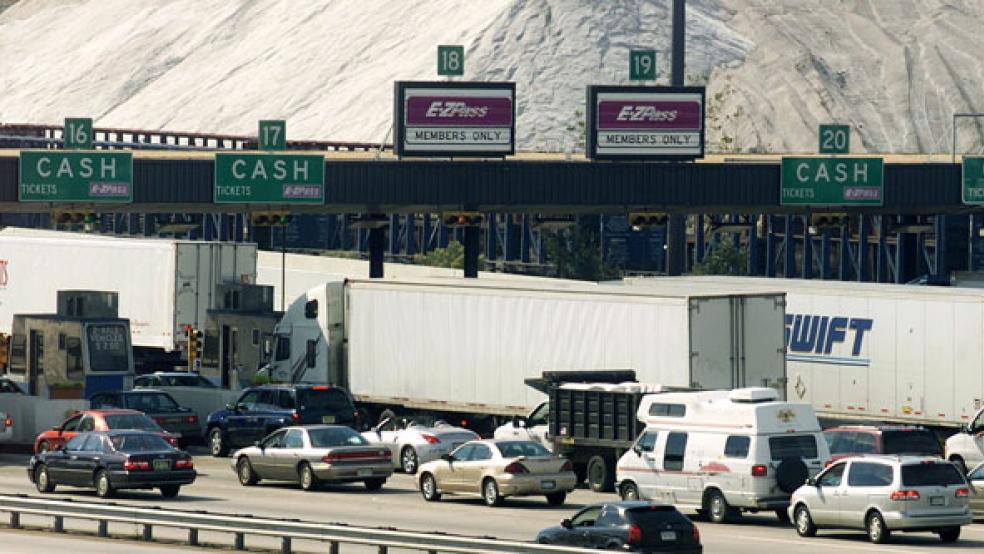As the gap between federal highway improvements and state transportation needs continues to widen, some states are quietly jacking up tolls to finance repairs, light rail projects and bridge maintenance.
This tactic by the states in response to a virtual freeze on federal gasoline tax revenues and the recent five percent reduction in federal transportation funds for the coming fiscal year is having a significant impact on commerce – especially the trucking industry – and could prove to be another drag on the economy as average Americans get hit with higher fees.
“States are using diversionary tactics to increase revenues without claiming it as a direct tax, which has been very devastating to the trucking industry,” said David Owen, president of the National Association of Small Trucking Companies. “We’re getting to where we’ll have to create a surcharge, which will inflate shipping, and the price will just go downstream to the consumer,” Owen said.
Among the increased toll fees currently in the works:
• The New York Thruway is considering a 45 percent toll increase on trucks, which will add $39 to the cost of a trip from Buffalo to New York. The new fee would raise that cost from $88 to $127.
• The Maine Turnpike Authority plans to raise tolls for all vehicles beginning Nov. 1. That will cost truckers who currently pay $20 an additional $8 – or four times the rate charged to cars.
• Gov. Bob McDonnell of Virginia has proposed slapping a $12 per trip toll on all trucks to finance a new tolling facility on Interstate 95 to drum up revenue to close the state’s budget gap.
• The Metropolitan Washington Airports Authority is considering a plan to drastically raise tolls on the Dulles Toll Road in northern Virginia to finance construction of a new light-rail Metro Silver Line that’s is being built for the Dulles International Airport.
Moreover, the New York and New Jersey Port Authority (NYNJPA) – which has increased tolls five times in the last ten years – is planning to increase tolls biennially through 2021, with trucks currently paying an average $30 to $39 to cross a bridge.
The boost in fees is forcing many trucking companies either to absorb the added expenses of these invisible taxes or pass them on to their customers, hindering an already fragile business climate.
FREE-WHEELING TOLL INCREASES
Congress cut federal highway funding from $41.1 billion to $39.1 billion in the fiscal 2012 transportation legislation that was passed this summer. While reducing federal funding levels, Congress made it easier for state and local government agencies to create or increase tolls, by ending a requirement that they first get approval from their state legislatures.
Desperate to make up for the funding loss, “states have found new ways to increase revenue for transportation-related purposes through increasing tolls,” said Ben Husch, policy director at the National Council of State Legislatures.
Jack McCammon, owner of Indiana-based McCammon trucking, pays an average of $7,000 per month on tolls and is beginning to feel the pinch. “We just had to raise our rates in February and we’re planning to raise them again soon,” McCammon told The Fiscal Times.
Top Ten Tolling Authorities | |||
| Tolling Authority | Revenue | ||
| MTA Bridges and Tunnels (NYC) | $1.4 billion | ||
| Port Authority of New York and New Jersey | $974 million | ||
| New Jersey Turnpike Authority | $952 million | ||
| Bay Area Toll Authority | $898 million | ||
| Pennsylvania Turnpike Commission | $740 million | ||
| Illinois State Toll Highway Authority | $690 million | ||
| New York State Thruway Authority | $641 million | ||
| Florida’s Turnpike Enterprise | $596 million | ||
| Harris County Toll Road Authority (Houston, Texas) | $481 million | ||
| North Texas Tollway Authority | $400 million | ||
| Source: International Bridge and Turnpike Association | |||
Still, not all the money collected from vehicles goes to highway improvements. While revenue from tolls are generally used on operating costs and road repairs, in New York and New Jersey, for instance, some of its toll revenue has subsidized construction on the World Trade Center and mass transit expenses. “These costs are going toward things that don’t benefit the drivers passing through,” said John Peters, economist and professor at the City University of New York.
Trucking companies in the toll-heavy Northeast are especially feeling the impact. Colleen Rejman, owner of Venice Enterprises, a midsized trucking company based in New York, said she is notifying her customers about a potential shipping rate increase to cover the company’s growing toll expenses. The company has already racked up $46,145 in tolls this year alone, or roughly $3,000 more than last year, when the company spent $43,361 on tolls by September.
Mike Durant, the New York state director of the National Federation of Independent Business, “It puts us at an unfair disadvantage as well as the businesses that won’t be competitive either if their forced to increase their rates because we charge them more,” Rejman said. “If they lose their business, I’ll lose my trucking.”
Dan Weiler, spokesman for the New York Thruway Authority, said the Thruway hasn’t increased toll prices in 17 years, so “we’re essentially playing catch up.” Weiler said an increase targeting trucks instead of cars is typical, because the revenue goes toward road repair, and large trucks with three axles or more generally cause more wear and tear on highways.
“It will enormously induce negative impact on virtually every segment of the business industry,” said Durant. “And it will go even further because consumers will ultimately pay the price. New York’s business climate is already at the bottom of the barrel and this is just another nail in that coffin.”



